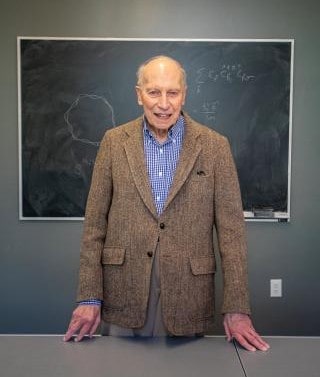New periodic table focuses on sustainability, gaining a physics PhD age 89
05 Nov 2021 Hamish Johnston
We do love an alternative periodic table here at Physics World, so I was chuffed to discover that the European Chemical Society has put a sustainable twist on its version of the table that displays the elements in terms of their abundance here on Earth
Any guesses regarding the most abundant element on Earth? Judging from the table it is oxygen, followed possibly by silicon and then maybe hydrogen. You might be wondering why I am not certain about the order. The reason, as you can see above, is that there are no numbers associated with the abundances. It is also not clear to me whether the abundances are given in terms of numbers of atoms on the planet or by mass – however, a little digging reveals that the areas are proportional to the numbers of atoms of each element on a logarithmic scale.
New in this latest version is the security of supply of the elements. This is important if they are used in key technologies such as mobile phones, which is designated in the table using an icon. Also highlighted is whether the production of an element occurs in areas of conflict.
Contentious carbon
The one element that had me scratching my head is carbon. According to the table there is a serious threat to some of the global supply of the element and that some of the global supply comes from conflict zones. According to the European Chemical Society this reflects the serious threat to the environment that the burning of carbon-based fossil fuels poses and the fact that some oil is extracted in areas of conflict.
Something I would like to see in the next version of this table is which elements are crucial to developing green technologies, and if we have enough of them. Hat trick: Manfred Steiner is three times a doctor. (Courtesy: Brown University).
Hat trick: Manfred Steiner is three times a doctor. (Courtesy: Brown University).
 Hat trick: Manfred Steiner is three times a doctor. (Courtesy: Brown University).
Hat trick: Manfred Steiner is three times a doctor. (Courtesy: Brown University).As someone who is getting a little long in the tooth, I’m always on the lookout for stories of physicists who have scored major achievements later in life. Meet Manfred Steiner, who at the age of 89 has just completed a PhD in physics from Brown University in the US. In his youth, Steiner loved physics but put that aside to follow his family’s advice and become a medical doctor. He first trained in his native Vienna before moving to the US, where he had a distinguished career in haematology before retiring in 2000.
That is when he rekindled his passion for physics and enrolled in Brown first as an undergraduate, completing his degree part time in 2007. Now he has completed his PhD with the approval of his thesis “Corrections to the geometrical interpretation of bosonization”.
By the way, this is Steiner’s second PhD, he had already done one in biochemistry. So, he is a doctor three times over.
“It is important not to waste your older days,” says Steiner, “There is a lot of brainpower in older people and I think it can be of enormous benefit to younger generations”.
FROM PHYSICSWORLD.COM 5/11/2021

Δεν υπάρχουν σχόλια:
Δημοσίευση σχολίου